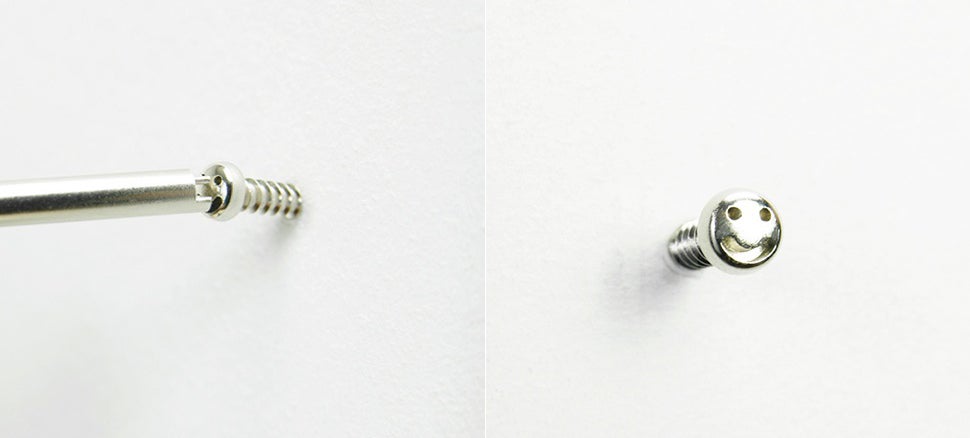
If ever there was a product designed to bring joy but ultimately destined to frustrate, it is these smiley face screws. They look beautiful, adorable, fun even. But you will shout and swear and stamp your feet every time you need to tighten them up.

If ever there was a product designed to bring joy but ultimately destined to frustrate, it is these smiley face screws. They look beautiful, adorable, fun even. But you will shout and swear and stamp your feet every time you need to tighten them up.

You may already start your day at Starbucks, and Starbucks is hoping that you'll soon want to close out your evenings there too. According to Bloomberg, Starbucks plans to offer alcohol in thousands of its store as a way to continue its growth. The drinks will be offered as part of an evening menu, which it's been testing in about 40 stores, only after 4PM. So far, the menu includes beer and wine alongside a small selection of light foods and deserts, such as a Blue Brie plate and chocolate fondue. The rollout to thousands of stores is expected to take several years.
Cadie Thompson, writing for CNBC, “Time Is Ticking for Apple to Announce an iWatch, Say Analysts”
Apple needs an iWatch sooner rather than later, or the company will risk losing its innovative edge to rivals, analysts say.
“They only have 60 days left to either come up with something or they will disappear,” said Trip Chowdhry, managing director at Global Equities Research. “It will take years for Apple’s $130 billion in cash to vanish, but it will become an irrelevant company … it will become a zombie, if they don’t come up with an iWatch.”
I’m guessing the ellipsis denotes when he paused for another line of coke.
 Electronic Arts has the rights to publish the sequel to Respawn shooter Titanfall, according to what GameSpot describes as a "reputable source." EA refused to comment on "rumor and speculation" to GameSpot, but the site says EA's option to secure the...
Electronic Arts has the rights to publish the sequel to Respawn shooter Titanfall, according to what GameSpot describes as a "reputable source." EA refused to comment on "rumor and speculation" to GameSpot, but the site says EA's option to secure the...

[All photos by Nick Solares]
Although New York City has long had a clearly defined and ubiquitous style of pizza, the city's appetite for the dish knows no bounds. While New Yorkers can certainly be parochial and protective of their home slice, they can also be open and accepting of different pizza points of view. Here is a look at the predominant forms of pizza found in New York City with information about how they developed over the years, and a glimpse at some of the more eclectic and disparate variations on the theme.
 The story of pizza in America begins in New York City in 1905 with Gennaro Lombardi, who began selling pizza out of his grocery store on Spring Street for the princely sum of a nickel per pie. The recipe had likely been handed down through the generations of the Lombardi family and adapted using local ingredients and cooking methods resulting in a form of pizza inspired, but distinct, from the original pizza of Naples. Pizza had unquestionably existed in America prior to 1905, but it did so in the domestic environment of the kitchens of Italian immigrants. Lombardi scaled this up to meet commercial demands.
The story of pizza in America begins in New York City in 1905 with Gennaro Lombardi, who began selling pizza out of his grocery store on Spring Street for the princely sum of a nickel per pie. The recipe had likely been handed down through the generations of the Lombardi family and adapted using local ingredients and cooking methods resulting in a form of pizza inspired, but distinct, from the original pizza of Naples. Pizza had unquestionably existed in America prior to 1905, but it did so in the domestic environment of the kitchens of Italian immigrants. Lombardi scaled this up to meet commercial demands.
The result was the most elemental form of NY pizza, often called Neapolitan-American, that shares much in common with the original Neapolitan type: a thin crust, a judicious covering of tomato sauce, and a smattering of fresh mozzarella cheese. But they differ in cooking technique, size, and texture. In Naples, the pies are cooked with wood and the center of the pizza tends to be soft and amorphous. Neapolitan pies are intended for one person and a knife and fork is required. The original NY pies were larger, averaging a 14"-16" diameter, and were cooked in coal fired ovens until crisp from edge to edge.
 [Lombardi's]
[Lombardi's]
Lombardi's thrived in Little Italy, feeding legions of factory workers and immigrants longing for a taste of home. It was so popular that Lombardi soon dispensed with the groceries entirely and started selling pizza exclusively. Numerous employees struck out on their own, fanning out across the city and spreading the distinctive style of pizza.
In 1924, Lombardi's employee Anthony "Totonno" Pero opened Totonno's in Coney Island. Five years later, John Sasso, also an employee of Lombardi's, opened John's Pizza on Bleecker Street. 1933 saw Pasquale "Patsy" Lanceri, reputed to have been a Lombardi's employee, open Patsy's in Harlem. Lombardi's, John's, Totonno's, and Patsy's are all still around today and represent cornerstones of the original NY style of pizza. (Lombardi's closed in 1984 and reopened a decade later in a different space on the same block.)
 [The coal oven at Grimaldi's]
[The coal oven at Grimaldi's]
Others followed suit serving this particular form of pizza. Arturo's on Houston Street opened in 1957 and remains a largely unblemished example of the breed, not having caught on with the tourists who these days flood nearby Lombardi's and John's. Lanceri's nephew Patsy Grimaldi opened Grimaldi's in Brooklyn in 1990. He had hoped to open in Manhattan, but by this time there was a ban on the use of the coal fired ovens that produce the intense heat and characteristically sooty crust of the Neapolitan-American style. He was forced to look for a grandfathered space in Brooklyn, which is the only way to use a coal oven within city limits these days. Luzzo's in the East Village was lucky enough to find such a space when it opened in 2005, inspiring what the owners dubbed "coal oven Neapolitan," an amalgam of Neapolitan and Neapolitan-American styles.
 [A gas powered pizza oven]
[A gas powered pizza oven]
The ban on coal ovens fundamentally changed the nature of pizza in NYC by forcing pizzerias to use other methods, of which gas ovens proved by far the most popular. This led to a democratization of the pizzeria by virtue of the lower costs associated with using prefabricated gas ovens, which by the post WWII years had become comparatively affordable vis-à-vis building a dedicated brick structure. But the postwar years also saw pizza breaking out of its "ethnic" designation, as returning GI's sought to satisfy the taste they had acquired for Italian pizza while liberating Europe. Soon, pizzerias where opening in neighborhoods all over the city, not just Italian American ones.

The most common and now quintessential form of NY pizza has thus become the type that is cooked in gas ovens rather than the Neapolitan-American type cooked with coal. NY style pizza is sold either as whole pies or by the "slice" — a triangular wedge cut from a whole pizza. Typically, an 18" NY pizza yields eight slices. With the exception of Patsy's, none of the original coal oven pizzerias sell pizza by the slice. The availability of slices of pizza fundamentally changed the nature of pizza in NYC, liberating it from the restaurant and substantially lowering the financial barrier of entry. NY style is virtually defined by the low cost of entry, the immediacy of service, and the portability of the product.
The NY style pizzas tend to have far more cheese than Neapolitan-American coal oven pies. The cheese typically covers the entire pie, with sauce only poking out along the circumference. A low moisture mozzarella is used rather than fresh mozzarella, which is not well suited to the lower temperature and longer cooking times of the gas ovens. Gas fired pizza lacks the sooty exterior that is a hallmark of coal fired ovens, but it still has plenty of crunch and snap to go along with the pliancy and springiness of the dough.
 [Dom DeMarco, Di Fara]
[Dom DeMarco, Di Fara]
In their purest form, NYC pizzerias will sell only pizza. Of course, many shops long ago added hero sandwiches and pasta dishes to their existing pizza menus, and later still wraps and even juices. These types of establishments might not have the culinary bona fides of the dedicated pizza joints, but they certainly serve a valuable function in many neighborhoods and any independent, locally owned NY pizzeria stands as a bulwark against a fast food joint or national chain store.
At its best, of course, a local pizzeria transcends the neighborhood and becomes a destination for diners. There is perhaps no greater example of this than Di Fara in the Midwood section of Brooklyn. It is run by Dom DeMarco who is as close to sainted as a pizzaiolo can be, and he has been slinging pies since 1961. But there are numerous others classic NYC style pizzerias that are worth a trip such a Joe's in Greenwich Village, Joe & Pat's on Staten Island, Lou & Ernie's in the Bronx, Rose & Joe's in Queens, and Sal & Carmine's on the Upper West Side, to name but a few.
 [A sicilian slice from Joe's Pizza]
[A sicilian slice from Joe's Pizza]
In addition to the classic round pizza, most every pizzeria also sells Sicilian style pies and slices. Characterized by a rectangular shape due to being pan cooked, with a crust that is generally over an inch thick, this style of pizza originated in the bakeries, not the pizzerias, of Sicily, where it is sold as Sfinciuni. In Sicily, Sfinciuni is topped with a tomato sauce spiked with anchovies and onions under a canopy of breadcrumbs rather than the tomato sauce and cheese we see in NYC. That latter recipe is the result of the American melting pot effect of throwing Neapolitans and Sicilians together into lower Manhattan. You can find a version of Sfinciuni sold at Prince Street Pizza as the Broadway Breadcrumb and also at Famous Ben's as the Palermo slice. Some of NYC's most storied pizzerias specialize in square slices like L & B Spumoni Gardens in Brooklyn and Rizzo's in Astoria, Queens.
Inevitably, the culture of small local pizza parlors succumbed to the expansionist impulse and someone decided to branch out and open a second location and then a third and so on. The most famous chain is probably Ray's, although here we are talking about several competing entities and a story which has a tangled and confusing history. The truly excellent original and now defunct Ray's, which was located on 59 Prince Street and dated back to 1959, spawned a slew of imitators such as Ray Bari, Original Ray's, Famous Original Ray's and World Famous Ray's. It got to the point where there was practically "a Ray's on every corner," as the old adage went, and the whole affair devolved into self parody as they tried to top each other with lawsuits and publicity stunts and by adding more cheese and thicker crusts to their recipes.
Aside from the various Ray's, there are a number of local chains such as Bravo, Famous Famiglia, and Abitino's that sell pizza by the pie and slice. They represent the middle ground of NYC pizza — workaday pies that offer solid value for money, if not the most inspired expressions of the art.
Patsy's is probably the most storied name associated with a chain, but you should know that it is the result of a licensing deal and that the pizza sold at the East Harlem original is quite different from the various Patsy's outposts that dot the city. The most recent chain to expand significantly is Artichoke Basille's, which introduced the artichoke slice from the founders' native Staten Island to the denizens of Manhattan with great success.
 [Valducci's Pizza truck]
[Valducci's Pizza truck]
Not surprisingly, pizza is well represented when it comes to food trucks in New York City. One can find everything from a $1 slice all the way up to a fancy Neapolitan pie. Pizza trucks actually anticipated the current food truck fad by several years. Midtown regular Jiannetto's got rolling in 1998, and Valducci's claims to have been in operation since 1999. Both pizza trucks can still be found on city streets. The Neapolitan Express pizza truck will soon open a brick and mortar location.
 [A $1 slice from Krust Pizza]
[A $1 slice from Krust Pizza]
The $1 slice has had an undeniable impact on the budget dining scene in NYC, especially in recent years. It has certainly eclipsed the beleaguered hot dog as the indigenous budget street food of choice. The era when a hamburger could be found at such a low price outside of a fast food chain is long gone and Halal street carts have become the dominant form of street food actually sold on the street.
The slice purist will scoff at the quality of the pizza at the $1 joints, which is inexorably compromised by virtue of their price point. Qualitative issues aside, the pizza sold at these $1 slice joints is still in the NY style. And sometimes it is hard to argue with the free market. The fact is that a kid with a $1 to spend on food is choosing between $1 slice and a dollar menu at a fast food joint, not necessarily the neighborhood pizzeria offering a top notch slice for $3.
 Of course in some cases the $1 slice has forced higher priced competitors to lower their prices in order to compete. Take Vinny Vincenz on First Avenue for example. Before Artichoke opened around the corner, it was the darling of food bloggers and pizza lovers in the area. The overnight success of Artichoke and then the opening of a Two Bros. pizzeria next door and a Percy's Pizza across the street, both offering $1 slices, forced Vinny Vincenz to follow suit. Even the local Papa John's franchise situated down First Avenue now offers $1 slices.
Of course in some cases the $1 slice has forced higher priced competitors to lower their prices in order to compete. Take Vinny Vincenz on First Avenue for example. Before Artichoke opened around the corner, it was the darling of food bloggers and pizza lovers in the area. The overnight success of Artichoke and then the opening of a Two Bros. pizzeria next door and a Percy's Pizza across the street, both offering $1 slices, forced Vinny Vincenz to follow suit. Even the local Papa John's franchise situated down First Avenue now offers $1 slices.
 [A bar pie from Lee's Tavern]
[A bar pie from Lee's Tavern]
Characterized by a thin, crisp crust and most often cooked in gas ovens in the back kitchens of bars, this type of pizza is not especially prolific in the city, at least compared to the slice joints. It is similar in form and substance to Midwestern pizza (see below) and it's more popular in other states. Lee's Tavern on Staten Island, which dates back to 1940, serves a notable bar pie.
 [A Neapolitan pie being made]
[A Neapolitan pie being made]
The most significant trend in New York City pizza in recent years has been the proliferation of the Neapolitan style. While the notion of ascribing "authenticity" to food is a tenuous one at best, there is ostensibly a standard that can be met in terms of Neapolitan pizza. The Verace Pizza Napoletana Association (VPN) is an Italian organization that certifies restaurants based on the employment of wood fired ovens and the use of a list of standardized ingredients of Neapolitan origin, such as 00 flour, San Marzano tomatoes, and buffalo mozzarella.
The first VPN certified establishment in NYC was La Pizza Fresca, which opened 20 years ago and is still going strong. Additionally Ribalta, Via Tribunali, and Naples 45 all hold VPN certification. But there are arguably higher expressions of the form beyond these restaurants. Una Pizza Napoletana, which has since relocated to San Francisco, really raised the stakes in terms of attention to detail, and some would say militancy, in recreating the original pizza of Naples using an imported oven and ingredients. Many Neapolitan pizzerias followed suit, most notably Motorino, Keste, and Don Antonio by Starita.
 [Pizza al taglio]
[Pizza al taglio]
When discussing Roman pizza, we are really talking about two distinct forms — the vanishingly thin pies generally cooked in wood fired ovens and served in sit down restaurants, and the pizza al metro (pizza by the meter) also known as pizza al taglio (pizza by the cut), which is sold both in bakeries and dedicated shops in the Italian capital.
The former is perhaps best represented by Gruppo, Posto, and Vezzo, which comprise a mini-chain of pizzerias that offer very thin, crisp crusts. They are similar structurally to Roman pizza although many of the toppings these pizzerias sell are distinctly American, such as ham and pineapple. The pizza al metro is well represented around town, most notably at Sullivan Street Bakery, which serves versions of pizza bianca (a hand stretched bread) and pizza pomodoro that would be the envy of most any Roman baker.
 [The bayou beast from Two Boots Pizza]
[The bayou beast from Two Boots Pizza]
Cajun pizza is actually a New York City creation courtesy of the Two Boots chain, which started off in the East Village in 1987 as a full service establishment. The conceit of the restaurant was that it was a fusion of the cuisines of Louisiana and Italy, but what emerged was something uniquely New York. By combining cornmeal crust, a spicy tomato sauce, and unexpected toppings (crayfish anyone?), Two Boots built a chain that now spans the nation but still retains some of the quirkiness of the East Village original.
If there is a style that sits in direct antithesis to the NYC street slice, it is assuredly the deep dish pizza that originated in Chicago. There is of course a famous rivalry between the two forms that often explodes into the popular zeitgeist, on talk shows and across the Internet. Many New Yorkers do not even consider the Chicago form to be pizza at all, dismissing it as a casserole. It has not made significant inroads in New York City. This is true even when factoring in Pizzeria Uno, the Chicago deep dish chain (now called Uno Grill and headquartered in Boston), which has been operating in NYC for a few decades. The now defunct Big Nick's on the Upper West Side sold a version that wouldn't convince anyone to switch allegiances and you sporadically see them pop up on random menus at restaurants like L'asso, with Emmett's being the most recent entrant.
 [Nicoletta]
[Nicoletta]
Distinct from Chicago deep dish, much of the pizza sold in the Midwest, including in Chicago, is actually quite thin with a crisp crust and a blanket of cheese and sauce. It is generally cut into squares, rather than wedges, which is referred to as a "tavern cut" or "party cut." Nicoletta in the East Village is one of the few example of the style, although the pizza is cut into wedges as is the local custom in NYC. The now shuttered Pulino's on the Bowery was notable in that it served a tavern style cut pizza.
This form differs from other Midwestern style pizza because it most often uses Provel, a processed cheese made of cheddar, Swiss, and provolone that was created in St. Louis decades ago. Speedy Romeo in Brooklyn serves just such a pie.
Grilled pizza was invented at Al Forno in Providence, Rhode Island, in 1980. There have been some limited explorations of the form in NYC. The late Vincent Scotto sold a version at the now shuttered Gonzo in Greenwich Village and before that at Fresco by Scotto, which continues to offer it on the menu. Coals, a dedicated grilled pizza restaurant, had an outpost in the Bronx that is now shuttered, but another location is still open in Westchester.
California style pizza was invented in 1980 by the late Ed LaDou, and it was popularized by Wolfgang Puck. The form is essentially the extension of the California cuisine ethos of using fresh, seasonal, and local produce into the realm of pizza. Suddenly words like "seasonality" and "local" and even "low fat" entered the pizza lexicon. The form found mass appeal with the California Pizza Kitchen chain, that currently operates two locations in NYC. But the notion of applying market ingredients and culinary technique found higher expression in the kitchens of NYC where places like the now defunct Zoe and the still-going-strong Mercer Kitchen started selling this type of pizza in the 1990s. More recently we have seen an explosion of so called flatbreads on menus across town.
 [Roberta's]
[Roberta's]
For lack of a better term, this category describes a particular aesthetic that is not characterized by any one pizza style as much as a dedication to inventiveness and using top quality, and often local, ingredients. The most obvious contributors to the form are Franny's and Lucali, later joined by Roberta's, and later still Paulie Gee's. One could also include less lofty operations such as Best Pizza, Pete Zaaz and Williamsburg Pizza to the roster.
Despite a wealth of vastly superior indigenous alternatives, chain pizzerias still exist in NYC. Pizza Hut, Dominos and Papa John's all have numerous locations throughout the boroughs, although commendably Staten Island, arguably the most suburban of the city's boroughs, has the least number of chains. While there are indeed distinctions between the pizza sold at the various chains they can be conveniently lumped together as a single style because they exist as much as a result of market research and analysis as through any great love of craft.
As we have shown, New York City has a rich pizza culture, one that is unparalleled in terms of diversity of form and proliferation of pizzerias. Pizza may have started in Naples but NYC may just be the epicenter of the art. There are, however, a few types of pizza that you won't find in NYC:
Trenton Tomato Pie
The longest continuously operating pizzeria in America is Papa's in Trenton, NJ which has been open since 1912. (Although Lombardi's preceded it by several years, it closed for a decade in the 1980's ceding the title to Papa's.) A "tomato pie" is for all intents and purposes a round pizza although one in which the cheese goes down first and is then topped by the sauce. While you find this practice in NYC, notably at L&B Spumoni Gardens in Brooklyn and any place serving a Grandma slice, there is no establishment selling a round version of a Trenton tomato pie.
New England
 [A New England style pizza]
[A New England style pizza]
Often called Greek or Diner style because it proliferates in the diners across New England, many of which are owned by Greek immigrants, this style is sort of a reconciliation of the Chicago and NY forms. It is cooked in oiled pans but is not as deep as Chicago pizza such that it can be served in wedges and eaten by hand if necessary. The closest version we know of is sold at the Mamaroneck Diner in Westchester.
New Haven
 [Frank Pepe]
[Frank Pepe]
One of the most revered forms of American pizza originates in New Haven, CT. The style shares much in common with the Neapolitan-American style. The pies are cooked in coal fired ovens giving them the same charr and they are sold as whole pies rather than by the slice. They differ in that they tend to be more irregularly shaped, more oblong than round, and are drier, with far less cheese. The closest restaurant that serves this type of pizza is Frank Pepe Pizzeria Napoletana in Yonkers, NY.
Great piece by Craig Hockenberry, thinking about Apple and wearable devices:
Given everything presented above, it’s pretty clear to me that a “smartwatch” isn’t in Apple’s immediate future. But they’re clearly interested in wearable technology. So what are the alternatives for a product that could be released this year?
The first step is to start looking at things from Apple’s point-of-view. I ask myself, “What problems can a wearable device solve?”
As I think about answers to that question, it leads me to the conclusion that Jony Ive and crew aren’t looking solely at the wrist. Wearable technology could take cues from other kinds of jewelry: rings and necklaces, for example.
Don’t read this and think, Apple’s making a ring. Read it and think, What if they’re making something that is not a “watch”?
You've probably seen instances of knolling without knowing there was a word for it. Knolling at the Apple Store:
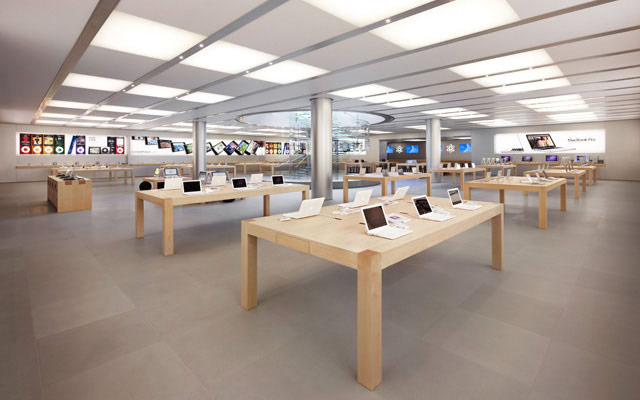
Knolling the contents of your bag:

Knolling a recipe for a book:

Knolling the parts of a machine:
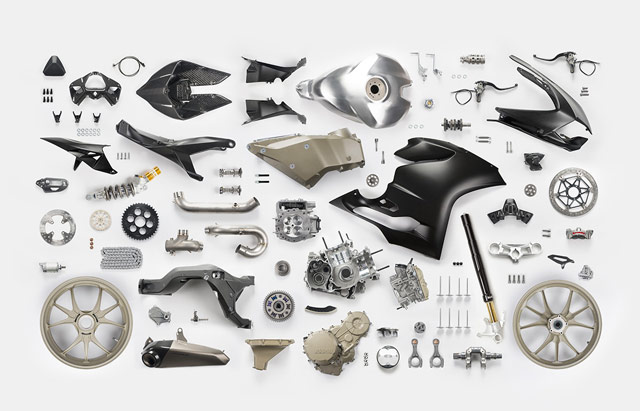
Knolling is the practice of organizing objects in parallel or at 90° angles. The term has been popularized by artist Tom Sachs; he picked it up from Andrew Kromelow when both were working at Frank Gehry's furniture fabrication shop. Gehry was designing chairs for furniture company Knoll, and Kromelow would arrange unused tools in a manner similar to Knoll furniture. Hence, knolling.

I wrote a post the other day about how name-brand mattresses are a scam and lower-cost alternatives. In a 2009 interview with Terry Gross on Fresh Air, Josh Kosman provided one reason why mattresses are so expensive: private equity firms.
In the mattress industry, private equity firms bought Sealy and Simmons, the number one and number two brands by a mile. They stopped really competing against each other. They cut costs, and they raised the prices of the mattresses. They started focusing only on the top end and stopped even making mattresses really for middle-income people that cost less than $1,000. So basically simplifying this over time, as they bought Simmons and sold it to another PE firm three or four years later, and same with Sealy, the buyers -- the sellers would make a lot of money, and the buyers felt, well, we can keep raising prices because there's no competition. We own Sealy, and we own Simmons. It's different firms, but they both have the same aim: to make a short-term profit, not to beat each other up on price. What happened over time was they couldn't raise the prices anymore, and the prices were raised double the price of inflation, double the rate of inflation. They cut the beds in half, so you came up with no-flip mattresses. That cut their manufacturing costs, but it also...
...it also sent their earnings soaring, even though the beds don't last as long. (thx, @gokari)
Tags: business Josh Kosman Terry Gross
Apple has re-released the fourth-generation iPad. The model replaces the aging iPad 2 in Apple's lineup. The fourth-generation iPad is priced at $399 —the same price as the iPad Mini with Retina Display, and $100 less than the iPad Air — and is only available with 16GB of storage. A cellular model is also available for $529.
The decision to replace the iPad 2 with the iPad 4 means that all of Apple's iPads are now using the company's Lightning connector and also makes the iPad Mini the only tablet from Apple not to feature a Retina Display. The iPad re-release is the second product change from Apple today. Earlier, the company released an 8GB version of the iPhone 5C in Europe, leading to speculation that the iPhone 4S — now the...

Last week, Sen. Dianne Feinstein (D-CA), chair of the Senate Intelligence Committee, gave a searing speech on Capitol Hill accusing CIA officials of hacking into computers to find an internal report that details the agency's torture tactics during the Bush years. Sources now tell Al Jazeera that the report outlines in great detail how the CIA engaged in interrogation tactics that went above and beyond what was legally authorized by President Bush after 9/11. The revelation lends credence to the allegations that the CIA went out of its way to rifle through Senate documents in an effort to cover the findings up.

Florida and other states have joined the US Department of Justice in reviewing Comcast's proposed buyout of Time Warner Cable. "We are part of a multi-state group reviewing the proposed transaction along with the US DOJ Antitrust Division," Florida's state attorney general's office told Reuters in a statement. The states, along with the Justice Department, are taking a close look at the controversial acquisition to determine whether it violates antitrust law. Comcast is the largest cable provider in the United States and announced its intent to buy Time Warner Cable — the second-place provider — last month.
Since then, many consumers and a wide variety of advocacy groups have voiced fierce criticism of the deal, though executives...
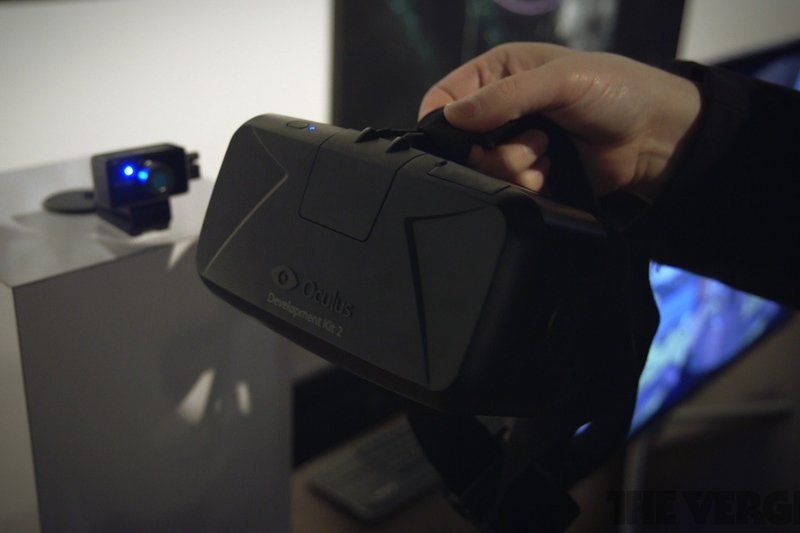
One year ago today, Oculus introduced the first version of its prototype virtual reality headset that wasn't literally held together with duct tape and glue. The $300 Oculus Rift Development Kit showed the world that inexpensive VR headgear was capable of being mass produced. Now, at the 2014 Game Developers Conference, the company is introducing development kit number two.
Starting today, Oculus is taking pre-orders for the Oculus Rift DK2, a refined version of the Crystal Cove prototype that blew us away at the Consumer Electronics Show in January, taking home our award for Best in Show. It also just so happens to be the last developer kit before the company announces the long-awaited consumer version of its headgear. Sony may just...

The Twitch office in San Francisco's Financial District takes up a whole floor of a Bush Street building that spans half a city block. The company's lobby has a wall of flat-screen televisions, each displaying a bright purple and white logo, "TWITCH, TWITCH TWITCH." To one side of the office are rows of desks that seat mostly 20-somethings typing lines of code while watching video streams. To the other side are meeting rooms themed after video game locations. There's the Rapture room, inspired by BioShock, which is decorated with its own fake fireplace and leather armchair. There's the Megaton room, inspired by the wasteland of a city from Fallout 3 — it's still a work in progress.
The 100 or so Twitch employees work to make sure the...

Dropbox will let you manage separate work and personal accounts on all of your devices next month, The Verge has learned. In advance of an April 9th press event, the company has notified users of its Dropbox for Business product that they will soon be able to access personal and work Dropbox files without logging in and out of their accounts. The company had announced it was working to support multiple accounts in November. Dropbox also plans to roll out new tools for administrators at the event, according to the email. The features will go live April 9th.

Starting next year, if you are really, really good at video games, you can use your gaming skills to get into one of South Korea's best universities—just like being a talented football or basketball player can help your admissions odds.
An anonymous user of 4chan has come up with a brilliantly harebrained scheme for their personal banking. They use video game retailer GameStop as a bank.

Here's how it works: whenever a paycheck comes in, this person goes to GameStop and pre-orders a bunch of upcoming video games. Whenever they need money, they go to the GameStop and cancel a game or two to make a withdrawal. Here's the entire scheme:
Does anyone else use Gamestop as a bank?
I got really pissed off with US Bank because I kept overdrafting my account even though I opted out, and the same thing happened with my credit union when I got a debit card.
Now whenever I get paid I go preorder a whole shitload of games. Whenever I need money, I go to the nearest gamestop and ask for my money back on a game I don't want and make a withdrawal. The lines are shorter at gamestop than at the bank and I can trade in old games and have money go straight to my savings account. Gamestops are just as prevalent as banks in my town and I work at a mall so it's even more convenient than running an errand to the bank or using an ATM and getting charged.
The gamestop people are starting to catch on that I'm just moving money around and only buying one preordered game a year, if that, but there isn't shit they can do about it. The best part is, since I always preorder every game coming out I'm still guaranteed to get all the exclusive content whether or not I'm sure I want a certain game. It's like they're rewarding me for banking with them.
I love the bits about the trade-ins and the rewards. (via @caseyjohnston)
Tags: finance GameStop moneyMaybe it doesn't belong in the annals of great literature, but Seth Stevenson's Slate piece on mattresses from November 2000 has been stuck in my brain for more than a decade. Mattresses are a scam, says Stevenson:
Is there a more maddening industry? They confuse us with silly product names (the Sealy Posturepedic Crown Jewel Fletcher Ultra Plush Pillowtop or the Sealy Posturepedic Crown Jewel Brookmere Plush?). They flummox us with bogus science ("pocketed coils"? "Microtek foundations"? "Fiberlux"?). And they weigh us down with useless features (silk damask ticking?). It's like buying a used car, and almost as expensive -- I've seen mattresses going for $7,000. What's a consumer to do?
The secret to mattress shopping is that the product is basically a commodity. The mattress biz is 99-percent marketing. So just buy the cheapest thing you can stand and be done with it, because they're pretty much all the same. And that's all you need to know. But do read on -- the world of sleep products is quite fascinating, and I'd like to share it with you.
So when I had to do some mattress shopping recently, I remembered reading a thread on Hacker News about Tuft & Needle. T&N is a start-up that, in the parlance of Silicon Valley VCs, is disrupting the mattress industry by offering products of similar quality at dramatically lower prices with an emphasis on customer service. Recode recently ran a piece on the company and their founders.
Park and Marino, who previously worked together at Los Angeles tech startup Mulu, turned to mattress-making in 2012 after Marino was disappointed by a $3,000-plus mattress. So the two posed as the owners of a small mattress store and called around to vendors to uncover the real cost of making Marino's expensive purchase. The final calculation -- a total of about $300 -- confirmed their suspicions: There was significant opportunity to improve.
When I looked on Amazon, Tuft & Needle's mattresses were, as billed, the top-rated mattresses on the site. So I bought one. (I also bought a DreamFoam bed, which is even cheaper than Tuft & Needle and also highly rated.) The beds from both companies come rolled up and vacuum packed. Once you puncture the thick plastic packaging, air comes whooshing back into the mattress, inflating to its proper size over a matter of hours. This process sounds exactly like the repressurization of an airlock from any number of sci-fi movies. As far as comfort goes, I can't tell the difference between these beds and the $1700 memory foam mattress from Design Within Reach.
So yeah, if you're in the market for a mattress, do some poking around...you might just save a few hundred dollars. (Note: these beds are memory foam beds, which are not everyone's cup of tea. I switched to one several years ago and love it. YMMV.)
Tags: business Seth Stevenson Tuft and NeedleInteresting mid-generation lineup move. $399 buys you a lot more iPad today than it did yesterday — retina display, A6X chip, better cameras, Siri, and more. This leaves the $299 iPad Mini as the last remaining non-retina iPad.
In other news: Apple today released an 8 GB iPhone 5C in a few non-U.S. countries. Not sure what the point of this is, given that it’s only about 8-9 percent cheaper than the 16 GB model.
Tim Cook:
This nonsense belongs with some of the other books I’ve read about Apple. It fails to capture Apple, Steve, or anyone else in the company.
Tell us what you really think, Tim.

[The dining room at Bouchon Bakery & Cafe via Facebook]
Thomas Keller's outpost of Bouchon Bakery in the Time Warner Center has, oh so quietly, begun serving dinner. It is now called Bouchon Bakery & Café, and serves a French-American menu of dishes like roast chicken with braised kale and white beans, lentil ragout with soft poached egg, and honey glazed pork belly with artichokes, charred eggplant, and Romesco sauce. A prix fixe option also offers two courses for $28 or three courses for $35.
The bakery, which occupies a small shop on the third floor of the Time Warner Center, has always had some lunch items and seating on the mezzanine. But now that dining area has table service and later hours. There is also a menu of wine, beer, and cocktails like a mimosa and a sherry mojito.
· Bouchon Bakery Turns Into a Cafe, Adds Dinner Service [Gotham]
· All Coverage of Bouchon Bakery [~ENY~]
Adam Fleischman, the man behind the Umami Burger chain, plans to open an Indian-Mexican restaurant in New York called Masty Roll. No word yet on where this restaurant will be, but he's shooting for a fall opening. That name again: Masty Roll. [Yahoo] [Photo]
 Update 10, which brings offline play to SimCity for the first time, is launching today after successfully coming through final testing. An announcement on the EA forums reads, "Today at 6AM PT we will be releasing Update 10 with Offline play. This...
Update 10, which brings offline play to SimCity for the first time, is launching today after successfully coming through final testing. An announcement on the EA forums reads, "Today at 6AM PT we will be releasing Update 10 with Offline play. This...

That is a bespoke running shoe made by a small company started by Hitoshi Mimura, who is considered one of the top shoe designers in the world. Mimura had great success at Asics, outfitting Olympic gold medal runners with shoes lighter, grippier, and more breathable than those worn by competitors, but now he has struck out on his own.
"I take 13 measurements of the foot, each foot has to be measured separately," explains the sensei of shoemaking. "I only trust hand-measuring. Currently, each shoe takes about three weeks to make, mainly due to determining which materials to use." Preparation is also key. "For a world championships or Olympics I check the course once or twice. I went to Beijing three times."
A NY Times feature on Mimura written before the 2008 Olympic Games in Beijing emphasized the designer's reliance on rice husks in the soles for grippiness. Mimura takes his job and his responsibility to the runners very seriously:
Surreptitiously, Mimura made soles of two slightly different thicknesses, to compensate for the fact that Takahashi's left leg was eight millimeters -- about a third of an inch -- longer than her right leg. She had tried a pair of the uneven soles before the Sydney Olympics, but felt uncomfortable.
Still, Mimura felt Takahashi needed such shoes to win and to avoid a recurrence of pain caused by the disparity in her legs. Without Takahashi's knowledge, Mimura gave her the uneven soles, then wrote a letter of resignation, in case she failed to win gold.
"I decided to take full responsibility because I made this pair against her wishes," Mimura said of the letter. "I didn't have to hand it over. It's still in my desk."
That is belief in yourself and in your craft. Many people believe in "giving people not what they want but what they need" but how many of them will put their livelihood on the line for it?
Tags: 2008 Summer Olympics design Hitoshi Mimura running shoes sports
Most average, everyday YouTube viewers are only able to flag videos for inappropriate content on an individual basis. But it turns out a growing group of "super flaggers" receive a powerful bonus privilege: they're able to flag up to 20 videos at once for an expedited screening process. A report from The Financial Times last week revealed that British authorities are among these super flaggers, and they're constantly scouring the video site for extremist propaganda. Today The Wall Street Journal went into deeper detail on the program, though it turns out governments play a smaller role than you might think.
Roughly 200 people and organizations are included in the pool of trusted flaggers, the Journal says, and less than 10 of those...
Here's more on ChocoChicken, which entrepreneur Adam Fleischman is betting will do for fried chicken what his Umami Group did for hamburgers. As the name suggests, it's indeed a combination of chocolate and fried chicken, and while that could be a scary mash-up in less-skilled hands, Fleischman swears the world's never tasted anything like it. "It plays with your mind," he says. "It doesn't harken back to what a burger should be or what chicken should be. It's its own category." Sides will apparently also be in their own category: White-chocolate mashed potatoes, and bacon biscuits topped with something called ChocoKetchup, are in the mix. [Fast Company, Related]
Read more posts by Clint Rainey
Filed Under: coming soon, adam fleischman, chocochicken
I love this rendering of an abandoned Paris Metro station reimagined as a swimming pool:
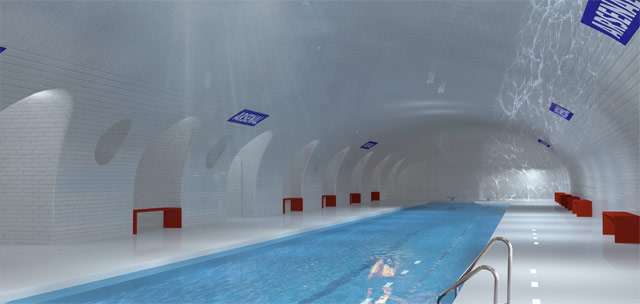
This and several other renderings were created by OXO Associates for Nathalie Kosciusko-Morizet's Paris mayoral race. The others imagine subway stations turned into theaters, nightclubs, and underground parks.
Tags: architecture Nathalie Kosciusko-Morizet Paris subway